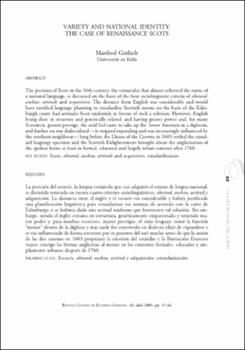Variety and National Identity
Author
Görlach, ManfredDate
2003Abstract
La posición del escocés, la lengua vernácula que casi adquirió el estatus de lengua nacional,
es discutida teniendo en cuenta cuatro criterios sociolingüísticos: abstand, ausbau, actitud y
adquisición. La distancia entre el inglés y el escocés era considerable y habría justificado
una planificación lingüística para estandarizar sus normas de acuerdo con la corte de
Edimburgo si se hubiera dado una actitud uniforme que favoreciese tal solución. Sin embargo,
siendo el inglés cercano en estructura, genéticamente emparentado y teniendo mayor
poder y, para muchos escoceses, mayor prestigio, el viejo lenguaje tomó la función
“menor” dentro de la diglosia y más tarde fue convertido en dialecto (dejó de expandirse y
se vio influenciado de forma creciente por su pariente del sur) mucho antes de que la unión
de las dos coronas en 1603 propiciara la cuestión del estándar y la Ilustración Escocesa
trajese consigo las formas anglicistas al menos en los contextos formales, educados y ampliamente
urbanos después de 1760. The position of Scots in the 16th century, the vernacular that almost achieved the status of
a national language, is discussed on the basis of the four sociolinguistic criteria of abstand,
ausbau, attitude and acquisition. The distance from English was considerable and would
have justified language planning to standardize Scottish norms on the basis of the Edinburgh
court, had attitudes been uniformly in favour of such a solution. However, English
being close in structure and genetically related, and having greater power and, for many
Scotsmen, greater prestige, the auld leid came to take up the ‘lower’ function in a diglossia,
and further on was dialectalized —it stopped expanding and was increasingly influenced by
the southern neighbour— long before the Union of the Crowns in 1603 settled the standard
language question and the Scottish Enlightenment brought about the anglicization of
the spoken forms at least in formal, educated and largely urban contexts after 1760.





